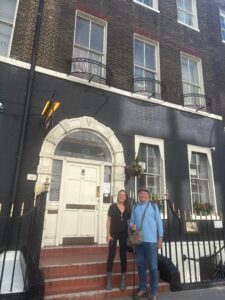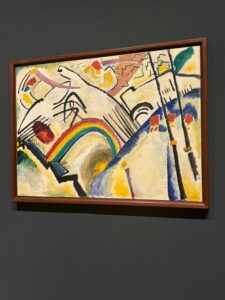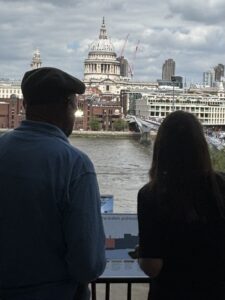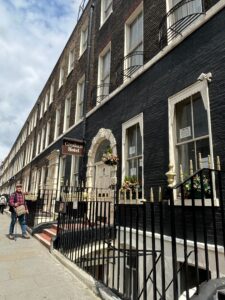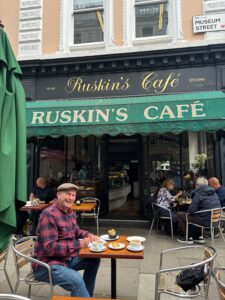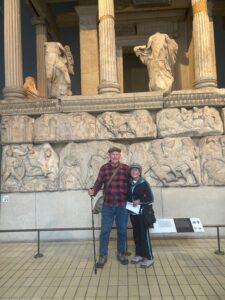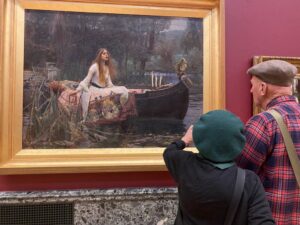Several drives into the Countryside in 10 Pictures
One of the creative moments feeding our souls

We set out to find a mystery country church that we had heard of worth visiting as it is said to have 12 beautiful Marc Chagall stained glass windows . It was about an hours drive to All Saints Church Tudeley .
There were no cars as we drove into the car parking area in the country side. No line up of people queued to enter as there was at the hot bread shop yesterday. There was a country peace and quiet so quite the swaying hum of barley in the field next door could be heard.

Elizabeth was the first to pull the very old wooden door to enter and I heard her gasp ‘O my goodness’ I followed and stopped in awe catching my breath with ‘O my ‘ The small church was full of scintillating mood of coloured light the ancient flood and wall stones were shimmering in swaying light and the windows , with the luminosity of Marc Chagall work waited for us .



All Saints Church in Tudeley, Kent, England, is the only church in the world that has all its windows in stained glass designed by Marc Chagall. “When Chagall dies Matisse will be the only one left that knows what colour is “ Picasso
One of the wonders of the Tudeley windows is that they are at eye level: one can go right up to them and see the marks of Chagall’s hands. He would scratch and mark his windows right up to the final stage of making – some say even after they were installed. This distinguishes the Tudeley windows from most of his other stained glass, which tends to be high up and hard to see.
(Some of his finest work in the medium is at the synagogue of the Hadassah Medical Centre in Jerusalem, depicting the Twelve Tribes of Israel – the Reuben window, in particular, prefiguring the east window at Tudeley and in a Zurich Cathedral. The most interesting window at present with thoughts of Gaza , according to my friend Andy . . .is at the is the Peace Window at the United Nations building in NY. a
How did Chagall happened to be present here in this tiny unknown church in the countryside.
The story goes a young jewish girl Sarah and her mother had seen and admired the Chagall designs for the Hadassah windows at an exhibition in the Louvre in Paris in 1961, and had been enthralled by them.
After the sudden death of Sarah in 1963, in a sailing accident, her parents living in the area of Tudeley, Sir Henry and Lady d’Avigdor-Goldsmid commissioned Chagall to design the magnificent east window. In commemorating the daughter of a Jewish father and an Anglican mother Chagall was an inspired choice. Chagall was a Jew, but one who often included Christ in his work, and who spoke of him as “the radiant young man in whom young people delight”.

Chagall was initially reluctant to take on the commission, but was eventually persuaded – and when in 1967 he arrived for the installation of the east window and saw the church, he said, ‘It’s magnificent. I will do them all.’
And over the next 15 years, Chagall designed all the remaining eleven windows, collaborating as usual with glassworker Charles Marq of Reims. The chancel windows were finally installed in 1985, the year of Chagall’s death at the age of 98 (replacing Victorian glass, now artfully backlit by a specially designed light-box installed in the vestry, at the suggestion of Sir Hugh Casson).
For myself I have always been curious of the famous Chagall windows at the Hadassah Synagogue in Jerusalem and the ones at The Fraumunster Church Zurich. I had accepted not to experience them and here I stand before 12 Chagall windows the east window inspired by the famous Reuben window in Jerusalem . What a beautiful gift to our world.
My favourite window is in the SW corner ( for the English where the su light gets in )

It is all golden and called the Resurrection window. It echoes the other windows as it also has birds of the air , beasts of the field and an angel albeit less obvious.
Picnic in the ancient peaceful cemetery

Country walks around the churches down in a barley field, path under the birch trees to a secret garden.

Kids and Michael enjoying the country side



2
With our spirits full I felt close to Heaven having been in the presence of Chagall I felt as if I could not take in any more when we read another tiny church i and half miles away across the field there was another country church –St. Thomas à Becket, Capel has a notable 13th century wall paintings and a yew tree under which Becket himself is supposed to have preached. It is a small Norman Wealden Church.

The tower was partly rebuilt after a fire in 1639. Inside, the crown-post roof is striking and there are some interesting fittings. Most significant however, are the extensive medieval wallpaintings which cover most of the nave.
Having been hidden by plaster for hundreds of years, evidence of these treasures was first discovered in 1868.
The north wall is a reminder of the colour and artistry which adorned England’s mediaeval churches before the Reformation. These paintings provided a kaleidoscope of visual aids to teach the Christian faith to ordi- nary people, who could neither read nor understand the Latin of the services and scriptures.
There were two tiers of scenes on the north wall. A horizontal frieze of zigzag riband pattern, about 4 feet (1.2m) from the floor, marked the bottom of the lower tier, and a frieze of scroll-work further up, divided the two tiers. These friezes, together with the lines which cover the wall and also the wide splay of the Norman window and the arch of the blocked doorway, with a masonry pattern, are thought to be the work of c.1200. and it reminds me of the work in the original Church in Hildegard’s Church which tells the biblical stories.
PS A footnote:
Hi Colleen,
Great to hear you were able to visit that church in England where Chagall designed/painted a beautiful stained-glass window. Elaine and I made a point of seeing his windows in a church in Zurich and a synagogue in Jerusalem on our pilgrimage to the ‘Holy Land’ in 2016.
As witnesses to Gaza’s unholy war, you and Marg may be interested is Chagall’s magnificent ’Peace Window’ at the United Nations building in New York.
Blessings and Love to all
Andrew

I have copied the image and description of the window from the UN website. [Photo in separate text]
“Peace Window” – Marc Chagall (Marc Chagall and the United Nations Staff Members – 1964)
The memorial, a stained-glass window about 15 feet (4,6 meters) wide and 12 feet (3,7 meters) high,
contains several symbols of peace and love, such as the young child in the center being kissed
by an angelic face which emerges from a mass of flowers. On the left, below and above, motherhood
and the people who are struggling for peace are depicted. Musical symbols in the panel evoke
thoughts of Beethoven’s Ninth Symphony, which was a favourite of Mr. Hammarskjöld’s.
Chagall’s own handwritten dedication (15 May 1963) reads:
“A tous ceux qui ont servi les buts et principes de la Charte des Nations Unies et pour lesquels
Dag Hammarskjöld a donné sa vie.”
[“To all who served the Purposes and Principles of the United Nations Charter,
for which Dag Hammarskjöld gave his life”.]
PSS a further footnote
Ah that’s so interesting, beautifully moves me to tears.
One of my treasured possessions is a copy of Dag Hammarskjöld’s book, Markings.
It’s old and brown. His words have been a comfort to me over the years,
he was and is an inspirational icon of goodness for me.
I’m sending a little of his words in the foreword. His death was so untimely,
believed perhaps to have been killed! Marg xx






















